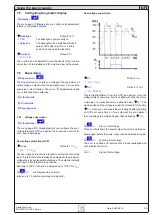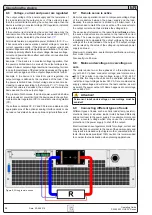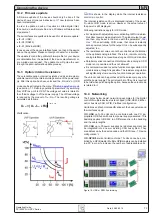
73
Operating Guide
PSI 8000 3U HS PV Series
EN
Date: 20-05-2016
14.2 Firmware update
A firmware update of the device should only be done if the
device shows erroneous behaviour or if new features have
been implemented.
In order to update a device, it requires a certain digital inter-
face card, a new firmware file and a Windows software called
„Update tool“.
These interfaces are qualified to be used for a firmware update:
•
IF-U1 (USB)
•
IF-R1 (RS232)
•
IF-E1 (Ethernet/USB)
In case none of the above interface types is at hand, the device
can not be updated. Please contact your dealer for a solution.
The update tool and the particular firmware file for your device
are obtainable from the website of the device manufacturer, or
are mailed upod request. The update too will guide the user
through the semi-automatic update process.
14.3 Option: Internal resistance
The unlockable option „internal resistance“ adds an imaginary,
variable resistor to the internal voltage source of the power sup-
ply. After this option has been unlocked, the „R mode“ or U/I/R
mode can be activated in the menu
Setup operation mode
(see section
„7.1. Defining operation parameters“
) by switching
from U/I/P resp. U/I to U/I/R. The voltage set value is related to
the off-load voltage U
o
of the power supply. The off-load voltage
is reduced by the product of I
act
Ri
set
. The resulting voltage is
calculated as follows:
I set, P set
U
Set
= (U
0
- I
Act
•
Ri)
Clarification:
Operating the device
CR
is shown in the display while the internal resistance
control is in control.
The internal resistance Ri
set
is displayed instead of the power
P
set
while U/I/R mode is active. However, the actual value of
the power is still displayed.
Following restrictions apply for U/I/R mode:
•
For models with adjustable power: activating U/I/R mode disa-
bles direct power value adjustment. The global output power
can then only be set in the menu with the parameter „
Padj
max.
“. When activating U/I/R mode, that value is instantly
set as power set value for the output. It can be subsequently
adjusted, too.
•
The resistance set value can not be controlled via the internal
or the optional analog interface. Therefore, remote control by
analog interface is not possible as long as U/I/R mode is active
•
Parallel or series connection of multiple units running in U/I/R
mode is not possible and thus not allowed!
•
It is not recommended to use the function manager while U/I/R
mode is active, though it is possible. The resistance regulation
will significantly slow down the function manager operation.
The unlock code can be purchased at the sales company who
sold the power supply. The serial number of the unit is required
to be told when purchasing the option, because the unlock code
is related to it.
14.4 Networking
The figures below depict networking examples for the digital
control of multiple devices in star-shaped (USB, RS232, Ether-
net) or bus-like (CAN, GPIB, Profibus) configuration.
Limitations and technical specifications of the bus systems and
the interfaces apply.
With
USB
up to 30 units can be controlled with one PC, ap-
propriate USB hubs with custom power supply assumed. This
basically applies to RS232, too. Differences lie in the handling
and the cable lengths.
With
CAN
up to 30 power supplies per address segment can
be integrated into a new or existing CAN bus system. They
are addressed by the device node and the RID (see „7. Device
With
GPIB
there is a limitation of max. 15 units on one bus, con-
trolled by a GPIB master. Multiple GPIB masters can be installed
in a PC in order to increase the number of addressable units.
Figure 15. USB or RS232 networking




































